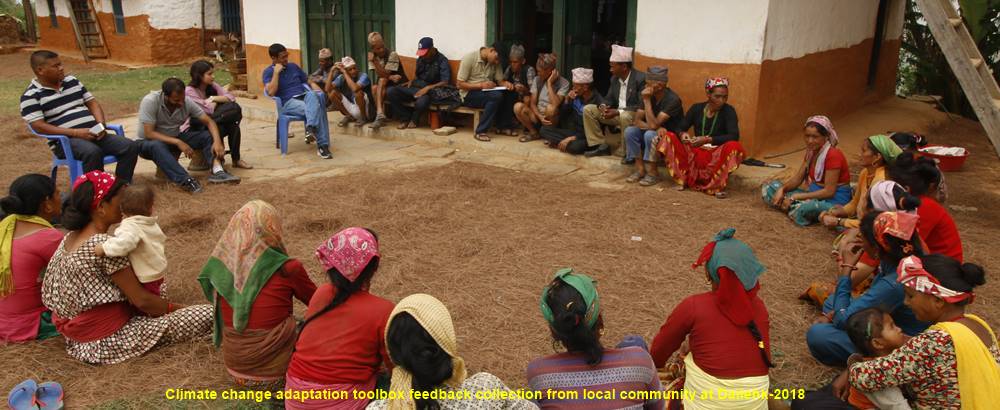ASHA Project aims to make self-reliant communities, organizations and local authorities to reduce the vulnerability of local communities to climate related risks and strengthen enabling institutional environment for climate change adaptation. Sub-watershed approach of the project envisions integrated adaptation planning to achieve the multiple objectives of conservation, sustainable natural resource management and climate change adverse impacts reduction. The project implements its programmes through active participation of local communities following Local Adaptation Plan for Action (LAPA). In order to achieve the above-mentioned goal/objective, the working strategies adopted by the project include; (i) strengthening the framework for local-level climate adaptation by (a) building adaptive capacity of participating communities and institutions; (b) adopting more holistic planning approaches taking sub-watershed (a project has envisioned a set of working approaches, strategies and actions for the effective implementation of the unit of planning and use of Geographic Information System (GIS) and Participatory Scenario Development (PSD) tool for LAPA development); and (c) the improvement of knowledge management and monitoring systems; and (ii) improving the resilience of vulnerable people through channelling project and government financing for implementing LAPA priorities at household and community/landscape levels to expand and diversify agricultural and other livelihood options. The project has two main components corresponding to the objectives: a) Framework for local-level climate adaptation strengthened and b) Climate resilience of vulnerable smallholder farmers improved. In addition, the project has project management component as its third and last component.
Working Mechanism
The project has adopted a participatory planning process with defined steps of formulating an Annual Work Plan and Budget (AWPB). The AWPB is considered a project mandatory management tool for planning, implementation, monitoring and reporting purposes, and including an apparatus for orienting and coordinating the actions of diverse institutions and stakeholders of the Project following comprehensive project implementation manual (PIM) and the logical framework of the project to achieve anticipated outcomes of the project. Moreover, establishing operational partnership with the government initiatives on climate change (bilateral projects/programme) is other working mechanism of the project. The ASHA Project strongly emphasises to develop linkages with a number of bilateral projects, programme of the GoN funded by donors such as the Department for International Development (DFID), the European Union (EU), The World Bank, The Asian Development Bank (ADB) and others to create platform for advancing evidence-based policy guidance and harmonization. Further, the project has given the special attention on Gender Equality and Social Inclusion (GESI) to ensure an average 50% representation of Dalit, ethnic groups, minorities where women will account for with at least 33% of the direct participating beneficiaries. Moreover, the project interventions are guided by Project Document Report (PDR) and PIM, IFAD Procurement Handbook and Guidelines. The Supervision Mission Report and an Approved Annual Work plan (developed in line with IFAD guidelines and Government of Nepal -GoN planning process). In addition, a number of thematic manuals, grant manual, guidelines, working procedures etc. required for the implementation of the plans and programmes/activities provisioned in the AWPB considered for project implementation. The project has adopted a decentralized project governance system with a technical assistance in built in each institutional structure. In order to facilitate, support, execute and monitor the AWPB in particular and overall project planning and implementation in general, a number of institutional arrangements equipped with a team of thematic specialist have also been established at the center and district or implementation levels. The project has taken the LAPA (endorsed by the concerned VDC (Now restructured into Rural Municipality (RM) and Municipality (M)) the entry point of project interventions. The lower government unit of the implementing institution has been Ward under the RM/M.
Costs and Financing
The Project cost is estimated a total of USD 37.6 million. This is inclusive of all contingencies, beneficiary contribution of USD 6 million equivalent primarily in the form of labour and materials, USD 6.6 million equivalents as counterpart funding from the government as the management cost including staff salaries, rentals and taxes and duties.
Institutional Arrangements
A number of institutions with well-defined roles and responsibilities have been established for the effective implementation of the project. A Project Steering Committee (PSC) at the national level, chaired by the Secretary, MoFE, oversees project implementation. In addition, the project has also assigned a number of service providers for the implementation of a few project activities.
Organogram


